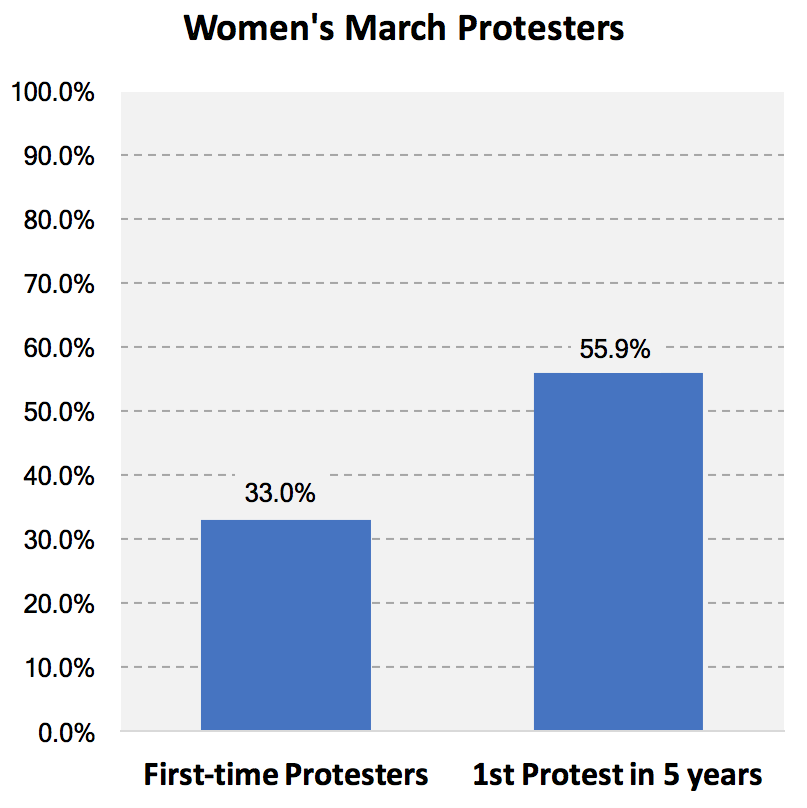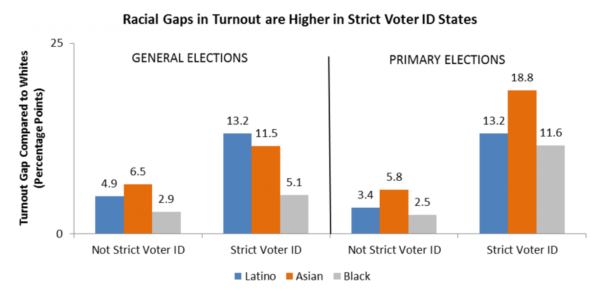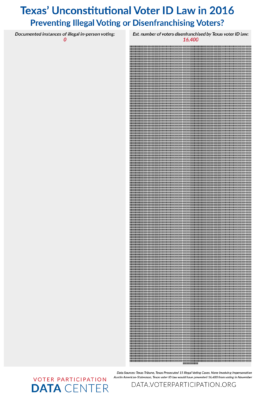IWPR: 5 Facts about Women and the Economy
For International Women’s Day and the “A Day Without a Woman” strikes occurring across America, the Institute for Women’s Policy Research has compiled together 5 important facts to know about women and the economy:
1. Hispanic women will wait 232 years for equal pay, if current trends continue.
2. Equal pay would cut poverty by more than half for working women and grow the U.S. economy.
3. Job Segregation keeps 1 in 4 working women in traditional care, serving, and cleaning roles with lowest pay.
4. Women account for only 1 in 3 workers in good, growing, middle-skill occupations.
5. A national paid leave policy could help young working mothers, a group least likely to have access to leave.
Read more from IWPR about these economic barriers women continue to face in our economy.
New Poll on Turnout Voters and Swing Voters - in 2016 and Beyond
A new PrioritiesUSA poll from Global Strategy Group and Garin Hart Yang provides important insight to two voting groups that were critical in the 2016 election: “swing voters” who supported Obama in 2012, and Trump in 2016, and “turnout voters” who voted in 2012, but stayed home in 2016. The research included a survey of 801 Obama/Trump voters, and focus groups in key swing states.
Key insights from the poll:
- In particular, non-college women present a key opportunity. Non-college women make up the largest proportion of Obama-Trump voters with mixed feelings about voting for Trump and thus present a particularly promising opportunity for persuasion efforts.
- Turnout voters – those who voted in 2012, but not 2016 – are disillusioned about politics, but extremely unhappy about the idea of a Donald Trump presidency. They were surprised about the 2016 outcome and are distraught about the prospect of four years under Trump.
- Turnout voters are also concerned about how Trump may unravel core protections that they value. Drop-off voters are concerned Trump will undermine women’s rights, do serious damage to the environment, and promote a divisive agenda.
Washington Post: Do voter identification laws suppress minority voting? Yes. We did the research.
New research published in the Washington Post confirms one of the worst-kept secrets in politics: Voter ID laws suppress minority voting.
“When we compare overall turnout in states with strict ID laws to turnout in states without these laws, we find no significant difference. That pattern matches with most existing studies. But when we dig deeper and look specifically at racial and ethnic minority turnout, we see a significant drop in minority participation when and where these laws are implemented.
Hispanics are affected the most: Turnout is 7.1 percentage points lower in general elections and 5.3 points lower in primaries in strict ID states than it is in other states. Strict ID laws mean lower African American, Asian American and multiracial American turnout as well. White turnout is largely unaffected.
These laws have a disproportionate effect on minorities, which is exactly what you would expect given that members of racial and ethnic minorities are less apt to have valid photo ID.”
Texas voter ID law would have prevented 16,400 from voting in November
“At least 16,400 Texans who voted in the November election wouldn’t have been able to cast ballots if the state’s voter identification law had been in full effect, state voting records show.” This report from the Austin American-Statesman is a chilling reminder of what experts agree is the true intent of such laws: disenfranchising voters.
“Travis County Clerk Dana DeBeauvoir said the volume of the declarations validates the concerns that the law’s opponents raised. “The voter ID law was going to take away the legal right to vote of 2,300 people” in the county, she said. The voters who signed those declarations, she said, “tended to be poor, tend to be elderly — maybe they weren’t born in a hospital or had other extenuating circumstances.”
Texas Attorney General Ken Paxton, whose office has defended the law, didn’t respond to a request for comment.”
However, former Texas Secretary of State Carlos Cascos, an Abbott appointee who stepped down after the November election, admits that the law would have prevented voters from casting their ballots: “Asked if that meant those voters would have been disenfranchised, Cascos said, “I would agree. That is a way to look at it.”
“And, he observed, the number of potentially disenfranchised voters “might not be important for a presidential race or a statewide race, but it very well might matter for local votes, where there can be really small margins.”
“At the end of the day, we want to make sure every qualified Texan who can vote should be allowed to vote,” he said, “(16,000) people wanted to vote and got to vote, so that’s great.”
Full story in the Austin American-Statesman.
Data on the Women's March: This is what Democracy Looks Like!
The numbers are in: “The Women’s March of 2017 was the largest protest in recent history, bringing together over 500,000 people in DC- the location of the flagship march, and over 2.9 million people nationwide.”
Their findings “suggest that the Women’s March has potentially lit the political fires of a new generation of activists and reactivated the political activism of others. Indeed, a third of the participants reported that the Women’s March was their first time participating in a protest ever. For over half of the participants (55.9%), the March was their first protest in 5 years (including those who had never participated before).”


Job Segregation Keeps 1 in 4 Working Women in Traditional Care, Serving, and Cleaning Roles with Lowest Pay
A new study by the Institute for Women’s Policy Research (IWPR) and Oxfam America finds that more than one in four employed women in the United States are concentrated in low-wage “women’s work”—such as teaching young children, cleaning, serving, and caring for elders—jobs that are done primarily by women, pay less than $15 per hour, and provide few benefits.
Workers in these female-dominated jobs, who are disproportionately women of color, earn less than men working in jobs with similar requirements for education, skills, stamina, and hours. For instance, maids and housekeepers, who earn $9.94 per hour, are 90 percent female, while janitors, who are mostly men, earn 22 percent more, at $12.13 per hour.
538: Men are treating 2016 as a normal election. Women aren't.
Harry Enten at FiveThirtyEight sums up the current polling:
We could be looking at the largest gender gap in a presidential election since at least 1952…The last time women favored either party’s nominee by more than 20 percentage points was in 1972, when Republican Richard Nixon crushed Democrat George McGovern among both sexes. The only Democrat ever to win women by more than 20 points was Lyndon Johnson in 1964.”
New Census Data Shows a Huge Gender Gap in Income
The U.S. Census Bureau’s latest report gives undeniable evidence of “a persisting large gender gap in incomes in the United States. The fact that nearly one fifth of all family households are headed by a single woman and that these households have incomes far below the national average, is cause for major concern.”
WIAReport continues, “for single women living alone, the median income in 2015 was $29,022. For single men living alone, the median income was $40,762. Thus, single women had a median income of 71.2 percent of the median income of single men.”
Indeed, the data shows that the median income for households headed by single women in 2015 was $37,797, and that these counted for 19% of all households in America.
Washington Post: Clinton and Trump’s demographic tug of war
Which candidates are earning the support of the Rising American Electorate? The Washington Post’s new graphic gives us some insight:
The presidential contest is often compared to a horse race, with the candidates fighting to finish in first place Election Day. We offer a bit of a different metaphor here. The campaign is also a series of simultaneously fought tug-of-war matches for different demographic groups — based on gender, age and race/ethnicity among others.
Our monthly Washington Post-ABC News poll provides a glimpse into which demographic groups Hillary Clinton and Donald Trump are attracting and how that support has changed over time.
Women and the Minimum Wage, State by State
In their new interactive report, NWLC explores why raising the federal minimum wage, and protecting tipped workers, is so important to helping women in America support themselves and their families. “Why? Because women represent nearly two-thirds of minimum wage workers across the country, and more than three-quarters of minimum wage workers in some states. Today, the federal minimum wage is just $7.25 per hour, and full-time earnings of $14,500 a year leave a family of three thousands of dollars below the federal poverty line. Twenty-nine states and the District of Columbia currently have minimum wages above the federal level, but in almost every state, the minimum wage leaves a full-time worker with two children near or below the poverty level.”
“… because women are the majority of workers who would get a raise, increasing the minimum wage would also help close the gender wage gap.



